All 3 entries tagged Isis
View all 4 entries tagged Isis on Warwick Blogs | View entries tagged Isis at Technorati | There are no images tagged Isis on this blog
December 07, 2021
Engraving Roman 'tesserae': the 'Vota Publica' tokens from Girolamo Tanini's collection
Since the sixteenth century, a special and enigmatic late Roman token emission, the ‘Vota Publica’ series, has received attention from antiquarians, dealers and collectors. These tokens, produced in either bronze or brass by the Roman mint, depict the effigies of Roman emperors from Diocletian (AD 284-305) to Valentinian II (AD 375-392) on the obverse (called the ‘imperial’ series). Instead of an imperial image they might also carry the busts of Serapis, Isis, or Hermanubis (or the jugate busts of Serapis and Isis) (called the ‘anonymous’ series). A number of ritual scenes and images referring to different aspects of Egyptian and Isiac cults are shown on the reverses, which are mostly accompanied by the legend ‘Vota Publica’ (= ‘public vows’). Due to the distinctive Egyptian religious iconography of these artefacts, a number of drawings or engravings of the ‘Vota Publica’ tokens appeared in several books, catalogues, and other contributions from the sixteenth to the early twenty centuries. These drawings reproduce, sometimes with a good degree of accuracy, some of the types found in the existing material, although the precise identification of the depicted specimens remains debated in most cases.
Two drawings reproducing ‘Vota Publica’ specimens are known to this author as showing an otherwise unattested obverse-reverse type combination. These designs were included by Girolamo (Hieronymus) Tanini in the plates of his ‘Supplementum’ to Banduri’s volume ‘Numismata Imperatorum Romanorum a Trajano Decio ad Palaelogos Augustos’ (Lutetiae, 1718), which was published in Rome in 1791 (Fig. 1)(Numismatum Imperatorum Romanorum a Trajano Decio ad Constantinum Draconem ab Anselmo Bandurio editorum Supplementum, Romae 1791). In this volume, Tanini catalogued hundreds of gold, silver and bronze coins from the reign of Trajan (AD 98-117) up to until that of Constantine XI Palaiologos (1149-1453). Most of the specimens recorded by Tanini existed as part his own collection, but others came from other collections or were taken from different books and catalogues. Girolamo Tanini was a priest and erudite greatly interested in numismatics, who served in Florence for the Rinuccini family as educator of Marquis Folco Rinuccini’s children Giovanni and Alessandro, as well as curator of the library housed in Palazzo Rinuccini. In this role, Tanini was also in charge of the numismatic collection of the Rinuccini family, which was initiated by Folco’s father, Marquis Carlo Rinuccini (1679-1748).

Fig. 1. Frontispiece of the ‘Supplementum’ by G. Tanini (1791).
In his ‘Supplementum’, Tanini described around seventy ‘Vota Publica’ tokens from both the ‘imperial’ and ‘anonymous’ series, most of which were part of his own collection. However, he only illustrated six of these specimens. Two of them, belonging to the ‘anonymous’ issue, came from Cardinal Stefano Borgia’s collection (1731-1804), and were later acquired by the Vatican. The other four were part of Tanini’s collection.
Of these, two display the pearl-diademed bust of the emperor Jovian facing right on the obverse, accompanied by the legend D N IOVIANVS P F AVG COS, while on the reverse is the type of Isis seated facing on high-backed throne, suckling Horus-Harpocrates (Fig. 2), or the type of Serapis-Agathodaemon and Isis-Thermouthis facing one another, carrying a sacred vase between them from which a serpent emerges (Fig. 3). The tokens depicted in these two drawings, labelled as AE2 (‘secundae formae’), might be identified with two rare specimens bearing the same obverse and reverse type and legend and with the same diameter, which are currently housed in the Vatican collection. The other two drawings provided by Tanini depict the draped bust of Isis facing left on the obverse, wearing a basileion and holding a sistrum in her right hand, while on the reverse is the image of Isis standing right on a galley with oars sailing right. Although these images are widely attested in the available material, none of the surviving specimens show a combination of these two types.
 |
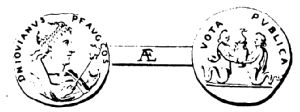 |
| Figure 2: Tanini 1791, p. 324, pl. VI. | Figure 3: Tanini 1791, p. 324, pl. VI. |
In the ‘Supplementum’, Tanini placed these two tokens under the coinage of Helena, the emperor Julian’s wife (died AD 360). As was common in his time, Tanini considered the busts of Serapis and Isis displayed on these tokens as disguised representations of Julian (AD 361-363) and Helena, following the idea that the production of some of these token issues was connected to Julian’s “pagan renaissance”. Tanini’s description of the two considered specimens is as follows:
1) TANINI 1791, p. 321, pl. VI:
Obverse: ‘VOTA PVBLICA (sic). Protome Isidis, vel Helenae, absque velo, cum flore loti, dextrorsum, d. sistrum, s. ad pectus gemmatum composita’.
Reverse: ‘VOTA PVBLICA. Isis sinistrorsum, stans in triremi, utraque manu velum regit’.
The first of the two specimens (Fig. 4) was labelled as AE3 (‘tertiae formae’) by Tanini. While the combination of the illustrated obverse and reverse types, with the legend VOTA PVBLICA occurring on both sides of the token, is not found in any of the known specimens today, it is worth paying attention to a similar specimen from the Vatican collection - Biblioteca Apostolica Vaticana (BAV) inv. no. Mt. Rom. Imp. Helena Iuliani 32. Although in a poor condition, this piece bears the same obverse type and legend as Tanini’s token, and the reverse also looks extremely similar with only one small difference: Isis has turned her head and is looking backwards (left), while on Tanini’s drawing Isis faces forward. It is tempting to assume that the specimen once owned by Tanini matches the Vatican piece, presuming that he misread the reverse type due to the poor condition of the token. However, no data on the acquisition of the piece by the Vatican collection is available. Moreover, the presence of a hole on the Vatican piece, which is not shown in Tanini’s drawing, may make this idea unlikely. If genuine, the piece described and figured in Tanini’s ‘Supplementum’ could provide evidence of an unrecorded ‘Vota Publica’ specimen.
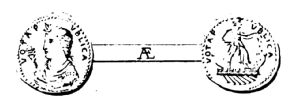 |
 |
| Figure 4: Tanini 1791, p. 321, pl. VI. | Figure 5: Tanini 1791, p. 322, pl. VI. |
2)TANINI 1791, p. 322, pl. VI:
Obverse: ‘DEA ISIS FARIA. Caput Isidis margaritis diadematum, collo duplici margaritarum monili ornato, humeris stolatis, d. sistrum’.
Reverse: ‘VOTA PVBLICA. Isis in triremi, sinistrorsum stans, velum tenet’.
The other specimen illustrated by Tanini (Fig. 5), labelled as A4 (‘quartae formae’), shows the same type combination of the previous piece, but it bears the obverse legend DEA ISIS FARIA instead of VOTA PVBLICA. As the available token specimens show, this legend was never used in the ‘Vota Publica’ series. Moreover, the obverse legend shown in Tanini’s drawing seems to incorporate two of the obverse legends found on the existing pieces with the bust of Isis, namely DE(ae) ISIDI (in the dative case) (Biblioteca Apostolica Vaticana (BAV) (inv. no. Mt. Rom. Imp. Helena Iuliani 30)) and ISIS FARIA (in the nominative case) (Fig. 6). If the piece drawn by Tanini was genuine, the legend DEA ISIS FARIA would be unique (an unicum). Actually, it is likely that the legend transcribed by Tanini was the result of a wrong interpretation. This is despite the fact that Tanini was aware that the legend ISIS FARIA, as well as the less common legend DE ISIDI, occurred on the obverse of the token specimens from the ‘anonymous’ series, as the specimens catalogued in his ‘Supplementum’ demonstrate.

Figure 6: AE, ‘Vota Publica’ token (19mm, 2.30g, 5h). Rome, IV century AD. Bertolami Fine Arts 24, 23.06.2016, lot 955, once part of the Archaeological Museum of Florence’s collection (MAF).
Sadly, the ‘Supplementum’ by Tanini is the only available source for the discussed specimens which, like much of the material published in his volume, are no longer traceable. Indeed, the Tanini collection is currently dispersed. This numismatic collection was incorporated at some point into the Ranuccini collection, which came in 1850 into the Medagliere Granducale of the Reale Galleria in Florence. In turn, the Medagliere Granducale was moved to the Archaeological Museum of Florence (MAF) since 1895. Regrettably, there is no trace of the ‘Vota Publica’ tokens described by Tanini either in the MAF collection or in their registers. As seen above, some of Tanini’s tokens may have been acquired by the Vatican collection at some point in the twentieth century, but the lack of data does not allow us to br certain on this point. Further archival research may hopefully shed light on the fate of the tokens that were once part of Girolamo Tanini’s collection.
This blog was written by Cristian Mondello as part of The creation of tokens in late antiquity. Religious ‘tolerance’ and ‘intolerance’ in the fourth and fifth centuries AD project, which has received funding from the European Union’s Horizon 2020 research and innovation programme under the Marie Skłodowska-Curie grant agreement No 840737.
Select Bibliography
- A. Alföldi, Isis-szertartások Rómában a negyedik század keresztény császárai alatt = A Festival of Isis in Rome under the Christian Emperors of the IVth Century, Budapest 1937.
- G. Capecchi et al., Palazzo Peruzzi. Palazzo Rinuccini, Rome 1980.
- H. Tanini, Numismatum Imperatorum Romanorum a Trajano Decio ad Constantinum Draconem ab Anselmo Bandurio editorum Supplementum, Romae 1791.
October 16, 2018
Converting Roman coins into tesserae: development and value
The conversion of Roman coins into coin-like objects is a practice documented during the imperial period. Although it is not always easy to date and determine the value of countermarks, incisions and other types of intervention on coins after their production, full academic awareness has not yet been acquired on the complexity of the reuse of coins in antiquity, which lost their previous economic function in order to acquire new meanings and purposes. In addition to pierced specimens – which were hung on the neck by a cord (funiculum) to be reused as amulets or jewels – official Roman coins were also transformed into tesserae by erasing their reverses and engraving Roman numerals on the surface instead.
 |
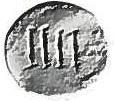 |
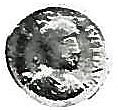 |
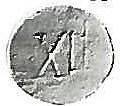 |
Figures 1-2: Late Antique coins with numerals scratched on the reverse. Both are bronze coins, BnF Paris.
The specimens shown above (Figs. 1-2), both held in the Bibliothèque nationale de France (BnF), bear on their obverses respectively the draped, cuirassed, and diademed bust of Julian the Apostate (on the left) and Theodosius I (DN THEODO-SIVS PF AVG) right (on the right). The reverses of both specimens were erased and smoothed, with the Roman numerals IIII and XII incised respectively. This phenomenon also appears to be attested on some earlier fourth-century bronze coins, e.g. those carrying the portrait of Maxentius and Constantius II (Alföldi 1975, Taf. 7, nos. 9-10) on the obverses. However, their conversion into tesserae may have occurred before, at the same time or even after that of the two pieces mentioned above.
 |
|
Figure 3: Bronze coin (Münzkabinett, Staatlichen Museen Berlin).
A specimen kept at the Münzkabinett in Berlin (Fig. 3) bears the bust of Julian the Apostate left on the obverse, while the image originally depicted on the reverse was erased and replaced with two engraved symbols, namely a palm branch and the monogram PE (“palma emerita”, “praemia emerita”?) whose meaning is controversial. Both motifs frequently occur on contorniates as well as on late Roman material culture, and they could allude to games and competitions or may have been used just as propitious and favourable symbols. Nevertheless, it is unclear how these motifs on contorniates were interpreted by their recipients, and even less clear how they connected with the function of the contorniates.
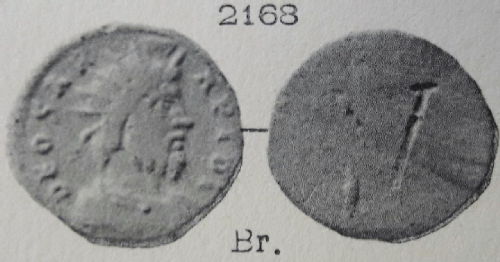 |
Figure 4: Vota Publica brass token (“Festival of Isis coinage”) (Collection H. Hoffmann, Médailles grecques et romaines, françaises et etrangers. Auktionskatalog Delestre-Rollin-Feuardent, 2-11 Mai 1898, Lot 2168).
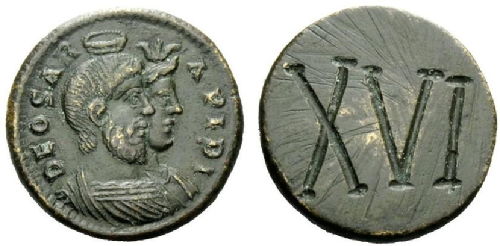 |
Fig. 5 Fig. 5: Vota Publica brass token (“Festival of Isis coinage”): Numismatica Ars Classica NAC AG, 23.05.2016, Auction 92, Lot 781. 2.75 g
Roman numerals could be engraved not only coins but even on tokens themselves, again converting them from one purpose to another. The two pieces shown above (Figs. 4-5) belong to the so-called “Vota Publica issues” (or “Festival of Isis coinage”) and, in particular, they have to be ascribed to the so-called “Anonymous series”, generically dated to the fourth century. A specimen carrys the radiate and draped bust of Serapis right, while the number V is incised on the reverse. Another piece, repeatedly published in auction catalogues since 1950, bears the crowned and draped busts of Isis and Serapis right, while the number XVI is engraved on the smoothed surface of the reverse. The obverse types of these two brass tokens show the same iconographies depicted on some Vota Publica specimens published by Alföldi (see Alföldi 1937, Taf. 7,31; Taf. 14).
Undoubtedly, the Roman numerals incised on the reverse of these coins and tokens evoke the Roman tesserae with numerals belonging to the Julio-Claudian period (27 BC – AD 68), which show the busts of members of the imperial dynasty or other depictions on the obverses, and Roman numbers generally within a laurel wreath – sometimes with the additional letters A or AVG – on the reverses. Also the so-called spintriae, characterized by erotic images (symplegma) on the obverses, carry Roman numerals on the reverses, at times connected by scholars to a ludic function (game counters) or an erotic context (“brothel tokens”). In addition to these two categories of tesserae, bone and ivory tokens also bear numbers written in both Latin and Greek on one side, and they were regarded as gaming counters on the basis of their findspots.
How should we interpret the coins as well as the Vota Publica specimens that were converted into tokens by engraving Roman numerals on their reverses? This kind of transformation of late Roman coins into tesserae suggests that they probably imitated earlier tokens carrying Roman numerals, and this presupposes a demand for this type of object also in the following centuries. The interpretation of these special “tesserae” is therefore closely related to the unknown function of earlier Roman tokens with Roman numerals, suggesting a continuity between the tokens of the earlier and later Roman period in terms of imagery and reception. New evidence could help to clarify the meaning of Roman numerals as well as the purpose and effects of these objects within Roman society across a longer term perspective.
This blog was written by Cristian Mondello, a British Academy Visiting Fellow at Warwick. This research is supported by the British Academy’s Visiting Fellowships Programme under the UK Government's Rutherford Fund.
Select Bibliography
Alföldi A., A Festival of Isis in Rome under the Christian Emperors of the IVth Century (Budapest 1937).
Alföldi A., ‘Heiden und Christen am Spieltisch’, JAC 18, 1975, pp. 19-21.
Bianchi C., ‘«Pedine alessandrine»: testimoni illustri di un gioco ignoto’, in Lambrugo C. & Slavazzi F. (eds.), I materiali della Collezione Archeologica “Giulio Sambon” di Milano (Milano, 2015), pp. 53-65.
Buttrey Th., ‘Spintriae as a Historical Source’, NC 13, 1973, pp. 52-62.
Campana A., ‘Le Spintriae: tessere romane con raffigurazioni erotiche’, in Morello A. (ed.), La donna romana. Immagini e vita quotidiana. Atti del convegno, Atina, 7 marzo 2009 (Cassino, 2009), pp. 43-96.
Küter A., ‘Roman tesserae with numerals – Some thoughts on iconography and purpose, in Rowan C., Crisà N. & Gkikaki M. (eds), Tokens: Culture, Connections, Communities, ed. by (London: Royal Numismatic Society, forthcoming).
Mittag P.F., Alte Köpfe in neuen Händen: Urheber und Funktion der Kontorniaten (Bonn 1999).
Perassi C., ‘Monete amuleto e monete talismano. Fonti scritte, indizi, realia per l’età romana’, Numismatica e Antichità Classiche. Quaderni Ticinesi 40 (2011), pp. 223-74.
October 26, 2016
Anubis Tokens and the Festival of Isis in Late Antique Rome
As part of the Token Communities project I have been examining the Roman lead tokens housed in the British Museum. Amongst the tokens are several that show the Egyptian goddesses Isis and Anubis. One example of these type of tokens is shown below: one side of the token shows Isis with a sistrum (a type of musical instrument associated with the goddess) and what may be a situla (a type of bucket). The legend on the left reads ACICI. The other side of the token shows the dog-headed god Anubis with a branch and a rather stylised sistrum.
 |
| Lead token with Isis on one side and Anubus on the other. |
The designs reminded me of the Isis coins of late antiquity, which are gathered together in Alföldi's 1937 book A Festival of Isis in Rome under the Christian Emperors of the IVth Century. Alföldi observed that even as late as the fourth century AD coins were being struck in Rome with the imperial portrait on one side and the Egyptian gods Isis and Sarapis on the other. Another series, which Alföldi called the 'anonymous' series, was also struck in the city. These had Isis or Sarapis on the obverse and various Egyptian motifs on the reverse: they did not name or show an emperor (an example is shown below). Alfödi suggested that this 'anonymous' series was created in the official mint after AD 378-9, the date at which coins showing the imperial portrait in association with Egyptian deities ceased. Alföldi believed that although the increasingly Christian emperors could no longer be associated with Isis or Sarapis, the (pagan) senatorial elite in Rome continued to produce coin-like objects for the festival of Isis, which could be given to their clients. Without the imperial portrait, these pieces weren't officially currency, Alföldi suggested, but instead were gifts given by select senators to their clients (and these pieces, in turn, may have later been used as playing pieces or small change).
 |
| 'Anonymous' issue with the portrait of Isis and figure of Anubis. |
On the anonymous series Anubis carries a sistrum and (stylised) caduceus, and is accompanied by the legend VOTA PVBLICA. This legend is also found on the coins struck with the imperial portrait, and probably references the fact that the festival of Isis in Rome was often connected with vows for the health and safety of the emperor. There are stylistic similarities, particularly with the sistrum held by Anubis, between the coins and the tokens. This, and the unusual appearance of Anubis at all, leaves me to wonder whether the lead tokens are not also from the same time period, and connected to the same, or a similar festival for Isis. If the elite were already creating 'anonymous' coin-like objects for use in the festival, perhaps the lead tokens with Anubis were a complementary or later development. While the Anubis British Museum tokens don't have any find data associated with them, they were catalogued by Rostovtzeff in his catalogue of tokens from Rome and the suburbs (Tesserarum Urbis Romae et Suburbi Plumbearum Sylloge no. 3190), and similar tokens were mentioned by Ficorini in his 1740 work. Specimens are also held in the Museo Nazionale in the Baths of Diocletian in Rome and in the Vatican, suggesting that maybe these are tokens that come from Rome, despite their Egyptian motifs. Other lead tokens also show strikingly similar imagery to the late antique coins associated with the festival.
Until further data is found this is just an idea, but perhaps we should add these tokens into the discussions of the yearly festival of Isis in late antique Rome.
This blog was written by Clare Rowan as part of the Token Communities project.
Anonymous series coin image reproduced courtesy of Numismatica Ars Classica, Auction 92 Part 1, lot 772.
 Clare Rowan
Clare Rowan

 Please wait - comments are loading
Please wait - comments are loading


 Loading…
Loading…

